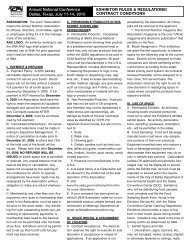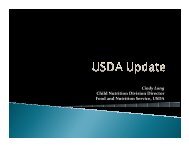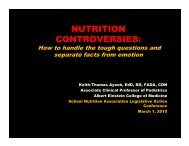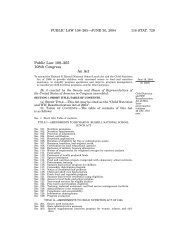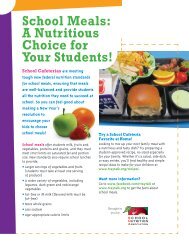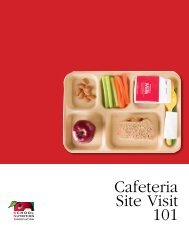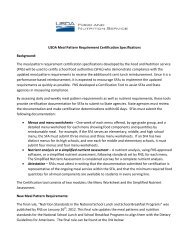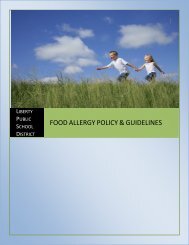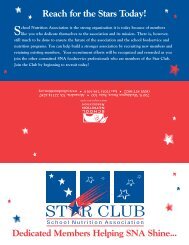Advice and Resources for Meeting the NSLP New Meal Pattern
Advice and Resources for Meeting the NSLP New Meal Pattern
Advice and Resources for Meeting the NSLP New Meal Pattern
Create successful ePaper yourself
Turn your PDF publications into a flip-book with our unique Google optimized e-Paper software.
2012 Annual National Conference<br />
We Can Do This:<br />
<strong>Advice</strong> <strong>and</strong><br />
<strong>Resources</strong> <strong>for</strong><br />
<strong>Meeting</strong><br />
<strong>the</strong> <strong>NSLP</strong><br />
<strong>New</strong> <strong>Meal</strong><br />
<strong>Pattern</strong><br />
July 15-18, 2012<br />
EXECUTIVE SUMMARY<br />
© 2012 School Nutrition Association. Created <strong>for</strong> School Nutrition Association by BullsEye <strong>Resources</strong> www.bullseyeresources.com.
2012 Annual National Conference<br />
Explore <strong>New</strong> Horizons July 15–18, 2012<br />
Denver, CO<br />
We Can Do This: <strong>Advice</strong> <strong>and</strong> <strong>Resources</strong> <strong>for</strong> <strong>Meeting</strong> <strong>the</strong> <strong>New</strong> <strong>Meal</strong> <strong>Pattern</strong><br />
• Presenters: Julie Brewer, Child Nutrition Division, Food <strong>and</strong> Nutrition Service, USDA<br />
Lynn Harvey, NCDPI, Section Chief, Child Nutrition Services, Raleigh, NC<br />
Penny McConnell, Director, Office of Food <strong>and</strong> Nutrition Services, Fairfax County Public Schools, VA<br />
Overview<br />
School nutrition leaders are preparing <strong>for</strong> sweeping changes in<br />
<strong>the</strong> school meal pattern <strong>and</strong> nutritional st<strong>and</strong>ards; schools will<br />
need to be ready to meet <strong>the</strong>se st<strong>and</strong>ards when <strong>the</strong> 2012–13<br />
school year begins. The new regulations are designed to improve<br />
<strong>the</strong> nutritional content of school meals in <strong>the</strong> hopes of changing<br />
how American children select foods in order to create a healthier<br />
nation.<br />
The new rules present a host of implementation challenges,<br />
however, from menu-planning logistics, to public relations, to<br />
procedural changes in <strong>the</strong> lunchroom. To assist school nutrition<br />
leaders in making this important transition, USDA <strong>and</strong> SNA have<br />
aggregated a rich array of downloadable resources, best<br />
practices, <strong>and</strong> tools.<br />
Context<br />
The speakers explained <strong>the</strong> new nutritional <strong>and</strong> meal pattern<br />
requirements <strong>for</strong> school meals, shared in<strong>for</strong>mation on resources,<br />
<strong>and</strong> answered common questions SNA has received on <strong>the</strong> topic.<br />
Key Conclusions<br />
• USDA’s new school meal regulations present an opportunity<br />
to make a difference in our children’s health.<br />
On July 1, 2012, sweeping new USDA regulations governing<br />
school meal st<strong>and</strong>ards became effective as a result of <strong>the</strong><br />
Healthy, Hunger-Free Kids Act. This legislation directed <strong>the</strong> USDA<br />
to update school meal nutritional requirements to align with <strong>the</strong><br />
latest “Dietary Guidelines <strong>for</strong> Americans,” which are based on<br />
Institute of Medicine recommendations <strong>and</strong> reflect current<br />
nutritional science.<br />
The objective is to address America’s childhood obesity problem<br />
by updating nutritional requirements <strong>for</strong> school lunches <strong>and</strong><br />
breakfasts so that meals are richer in nutrients <strong>and</strong> lower in<br />
calories, saturated fats, sugar, <strong>and</strong> sodium. The new rules will<br />
increase <strong>the</strong> variety of fruits, vegetables, whole grains, <strong>and</strong><br />
lower-fat milk offered in school meals <strong>and</strong> eliminate trans fat.<br />
The hope is that <strong>the</strong>se updates will change how children eat at<br />
school <strong>and</strong> home, creating better food choice habits that last a<br />
lifetime.<br />
This is an exciting time but a challenging one <strong>for</strong> those who are<br />
charged with implementing <strong>the</strong>se changes be<strong>for</strong>e doors open <strong>for</strong><br />
<strong>the</strong> 2012–13 school year. On one level, <strong>the</strong> new rules present an<br />
opportunity to effect lasting, beneficial change in <strong>the</strong> lives of<br />
many, creating a healthier nation. On a practical level, however,<br />
making <strong>the</strong> many adjustments that are required will be difficult.<br />
• Implementation of <strong>the</strong>se new nutritional st<strong>and</strong>ards will<br />
present significant challenges.<br />
Compliance with <strong>the</strong> new meal pattern <strong>and</strong> nutritional st<strong>and</strong>ards<br />
regulation is not optional. Every reimbursable meal must meet<br />
<strong>the</strong> requirements. Schools cannot choose to <strong>for</strong>ego implementing<br />
<strong>the</strong> changes. The additional $0.06 per meal <strong>the</strong>y will receive<br />
from <strong>the</strong> government must meet requirements established by<br />
USDA.<br />
Yet complying with <strong>the</strong> new st<strong>and</strong>ards will be tough. Menu<br />
design will have to be totally rethought in light of <strong>the</strong> many<br />
differences from past nutritional requirements:<br />
<strong>New</strong> groupings. The new rules require food-based menu<br />
planning, which eliminates previous options. They categorize<br />
foods in more specific ways. For example, no longer are fruits<br />
<strong>and</strong> vegetables interchangeable on a menu. Vegetables are<br />
now grouped by color/type (e.g., dark green, red/orange,<br />
peas/ beans/legumes), with a weekly requirement <strong>for</strong><br />
offerings in each group. Distinctions are made between<br />
whole-grain foods <strong>and</strong> o<strong>the</strong>r grains.<br />
Daily minimums/weekly maximums. Servings of meats/meat<br />
alternates <strong>and</strong> grains/grain equivalents are highly regulated,<br />
subject to new daily minimums <strong>and</strong> weekly maximums.<br />
Among frequently asked questions SNA has received concern<br />
how to stay above daily minimums without running over<br />
weekly maximums, all while remaining within <strong>the</strong> new caloric<br />
ranges <strong>for</strong> meals.<br />
More precision in measurement. In measuring, food quantities<br />
now must be rounded down to <strong>the</strong> nearest quarter-ounce.<br />
That is critical <strong>for</strong> compliance, but will take getting used to<br />
<strong>and</strong> will require staff training.<br />
Different st<strong>and</strong>ards <strong>for</strong> different grades. Menu requirements<br />
differ by grade, with three different sets of requirements <strong>for</strong><br />
K–5, Grades 6–8, <strong>and</strong> Grades 9–12. No longer can <strong>the</strong> same<br />
menu be served to K–5 kids <strong>and</strong> high school students.<br />
Schools with grades K–8, however, may use <strong>the</strong> same menu<br />
<strong>for</strong> all grades, but <strong>the</strong>y will need to put processes in place to<br />
ensure that <strong>the</strong> right quantities are served to <strong>the</strong> appropriate<br />
grades.<br />
The USDA’s side-by-side comparison of old <strong>and</strong> new regulations<br />
is available here.<br />
Adding ano<strong>the</strong>r layer of challenge are <strong>the</strong> Public Relations <strong>and</strong><br />
education pieces. Students will need to be educated to choose<br />
among offerings in each group (versus taking two items of one<br />
Page 1<br />
Created <strong>for</strong> SNA by:
2012 Annual National Conference<br />
Explore <strong>New</strong> Horizons July 15–18, 2012<br />
Denver, CO<br />
food group <strong>and</strong> none of ano<strong>the</strong>r) if intended meal components<br />
are to end up on student meal trays. Parents, school staff, <strong>and</strong><br />
<strong>the</strong> community will need to underst<strong>and</strong> why <strong>the</strong>se changes are<br />
necessary <strong>and</strong> <strong>the</strong> school district’s approaches to implementing<br />
<strong>the</strong>m.<br />
“Use this as an opportunity to engage parents. And<br />
it's a great time to engage students in making<br />
healthier choices. Schools can set an example.”<br />
Lynn Harvey<br />
• Fortunately, plentiful tools, resources, <strong>and</strong> best practices<br />
to help facilitate this transition are just a click away.<br />
SNA <strong>and</strong> USDA recognize <strong>the</strong> need <strong>for</strong> in<strong>for</strong>mation <strong>and</strong> tools to<br />
help districts <strong>and</strong> schools comply with <strong>the</strong> new rules. Some of <strong>the</strong><br />
resources are:<br />
SNA Guidebook, We Can Do This<br />
SNA has an ad hoc working group to help members underst<strong>and</strong><br />
<strong>the</strong> new meal requirements, access in<strong>for</strong>mation <strong>and</strong> sample<br />
menus, <strong>and</strong> navigate <strong>the</strong> menu-certification process. SNA<br />
members can download <strong>the</strong> group’s “how-to” guide, We Can Do<br />
This: <strong>Advice</strong> <strong>and</strong> <strong>Resources</strong> <strong>for</strong> <strong>Meeting</strong> <strong>the</strong> <strong>NSLP</strong> <strong>New</strong> <strong>Meal</strong><br />
<strong>Pattern</strong>, here. Among its features, <strong>the</strong> guidebook includes a PR<br />
tool kit. It has a sample letter to parents, a sample press release,<br />
talking points, <strong>and</strong> a brochure <strong>for</strong> kids. Sample menus are<br />
included too.<br />
“The how-to guide that <strong>the</strong> ad hoc group created<br />
is a living document that will constantly be<br />
updated <strong>and</strong> revised.”<br />
Penny McConnell<br />
USDA’s Best Practices Sharing Center<br />
USDA has created an online Best Practices Sharing Center: here.<br />
School food authorities <strong>and</strong> state agencies with resources, tools,<br />
<strong>and</strong> success stories to share can upload materials by emailing<br />
hmrs@ars.usda.gov.<br />
Those seeking solutions <strong>and</strong> ideas <strong>for</strong> implementing <strong>the</strong> new<br />
rules most effectively can search <strong>the</strong> site by topic (e.g., dietary<br />
specification, meat/meat alternates, monitoring tools) or <strong>for</strong>mat<br />
(e.g., menu, recipe, checklist, training materials, success<br />
stories/method of implementation).<br />
More USDA In<strong>for</strong>mation <strong>and</strong> <strong>Resources</strong><br />
The USDA also offers:<br />
A sample menu: here.<br />
Downloadable slides presenting an overview of <strong>the</strong><br />
regulations <strong>and</strong> related issues, to use in staff training<br />
sessions: here.<br />
Policy memos that explain specific features of <strong>the</strong> regulations,<br />
such as <strong>the</strong> regulations on grains: here.<br />
Contact people in each state agency: here.<br />
Fur<strong>the</strong>r in<strong>for</strong>mation on <strong>the</strong> new regulations, technical<br />
assistance, <strong>and</strong> guidance: here.<br />
“Use <strong>the</strong> tools from <strong>the</strong> USDA, which should<br />
clarify everything <strong>for</strong> you. Everything is included<br />
<strong>and</strong> is constantly being updated."<br />
Julie Brewer<br />
The in<strong>for</strong>mation contained in <strong>the</strong>se summaries reflects BullsEye <strong>Resources</strong>, Inc.’s subjective condensed summarization of <strong>the</strong> applicable sessions from<br />
School Nutrition Association’s 2012 Annual National Conference "Explore <strong>New</strong> Horizons." There may be material errors, omissions, or inaccuracies in <strong>the</strong><br />
reporting of <strong>the</strong> substance of <strong>the</strong> sessions. In no way does BullsEye <strong>Resources</strong> or School Nutrition Association assume any responsibility <strong>for</strong> any in<strong>for</strong>mation<br />
provided or any decisions made based upon <strong>the</strong> in<strong>for</strong>mation provided in this document.<br />
Page 2<br />
Created <strong>for</strong> SNA by:
2012 Annual National Conference<br />
Explore <strong>New</strong> Horizons July 15–18, 2012<br />
Denver, CO<br />
FAQ<br />
1. How can I communicate <strong>the</strong>se new meal pattern<br />
changes to my parents, students <strong>and</strong> employees?<br />
2. How can I meet <strong>and</strong> count <strong>the</strong> minimums <strong>and</strong><br />
maximums <strong>for</strong> grains/breads?<br />
3. How do I address <strong>the</strong> concerns that <strong>the</strong> one-ounce<br />
portion of protein does not seem like enough <strong>for</strong><br />
students, especially middle school students?<br />
4. How do I identify <strong>and</strong> account <strong>for</strong> <strong>the</strong> correct portion<br />
sizes when I have mixed grades <strong>and</strong> <strong>the</strong> students<br />
come through <strong>the</strong> serving line in no set grade<br />
structure?<br />
5. What are some marketing ideas on fruits <strong>and</strong><br />
vegetables to educate students on <strong>the</strong>ir choices to<br />
avoid food waste? What are some positive ways to<br />
encourage kids to take vegetables or fruits when<br />
<strong>the</strong>y are not used to eating <strong>the</strong>se items at home?<br />
6. How do I account <strong>for</strong> components when <strong>the</strong>re is<br />
more than one “entrée” choice on <strong>the</strong> menu? All<br />
students go through <strong>the</strong> same line, but may choose<br />
between two or more main item options.<br />
7. Where can I find resources to assist me in<br />
implementing <strong>the</strong> new meal guidelines?<br />
SNA RESPONSE<br />
A PR tool kit is available to SNA members in <strong>the</strong> guidebook, We Can Do<br />
This: <strong>Advice</strong> <strong>and</strong> <strong>Resources</strong> <strong>for</strong> <strong>Meeting</strong> <strong>the</strong> <strong>New</strong> <strong>Meal</strong> <strong>Pattern</strong>, with a<br />
sample letter to parents in English <strong>and</strong> Spanish, sample press release,<br />
<strong>and</strong> brochure to send home in backpacks.<br />
Rounding to <strong>the</strong> nearest 1/4-ounce equivalent is a critical concept you<br />
need to underst<strong>and</strong> in order to implement <strong>the</strong> new program. Example: You<br />
need to serve at least 1 ounce of grain per day <strong>and</strong> a maximum of 8–10<br />
ounces per week <strong>for</strong> Grades 6–8. If you offer more than one grain at a<br />
meal, you must add <strong>the</strong> weights of <strong>the</strong>se grains toge<strong>the</strong>r <strong>and</strong> stay within<br />
<strong>the</strong> daily maximum <strong>and</strong> minimum range — always rounding to 1/4 ounce.<br />
All five daily servings must add up to meet <strong>the</strong> weekly minimum yet not<br />
exceed <strong>the</strong> weekly maximum.<br />
Meat/meat alternates have a daily minimum of a 1-ounce equivalent. But<br />
<strong>the</strong>re is a weekly range of 8–10 ounce equivalents per week <strong>for</strong> students in<br />
K–5, <strong>and</strong> 9–10 ounce equivalents <strong>for</strong> Grades 6–8. This means that on most<br />
days, students will have at least 2 ounces of meat/meat alternates.<br />
Consider: if you serve middle school students a hot dog with chili one day<br />
that totals 2.5 ounce equivalents, you would have three days in which you<br />
could serve 2-ounce equivalent main dishes <strong>and</strong> only one day during <strong>the</strong><br />
week where you would serve a 1–1.5 ounce equivalent.<br />
This situation can occur in schools in which 8 th graders are eating lunch<br />
with kindergartners, etc. You will have to make modest adaptations to<br />
identify <strong>the</strong> grade levels of <strong>the</strong> children, as necessary.<br />
Ask <strong>the</strong> students, even kindergartners, what recipes <strong>the</strong>y enjoy most. Test<br />
recipes <strong>and</strong> be open <strong>and</strong> receptive to students’ input, even when it is<br />
negative. Promote positive student participation. Encourage healthful<br />
choices at school. Get creative with your vegetable recipes. Use <strong>the</strong> “Fruits<br />
<strong>and</strong> Vegetables Galore” in <strong>the</strong> USDA resources.<br />
If you plan your entrees correctly, this should not be an issue. For<br />
example, if breakfast has three components <strong>and</strong> you offer four, it is okay<br />
<strong>for</strong> students to decline one component. Help <strong>the</strong> children underst<strong>and</strong> that<br />
<strong>the</strong>y have to choose between options. One idea is to use educational<br />
kiosks that show <strong>the</strong> menu of <strong>the</strong> day. All reimbursable meals must have<br />
<strong>the</strong> right components under <strong>the</strong> new rules.<br />
Use <strong>the</strong> guides provided by <strong>the</strong> USDA <strong>and</strong> <strong>the</strong> SNA. Use your tool kit.<br />
Network among your colleagues <strong>for</strong> new ideas — you can do this now at<br />
<strong>the</strong> convention. Avoid using sample menus verbatim. Keep in mind we<br />
have <strong>the</strong> opportunity to reshape how Americans eat, not just at school, but<br />
everywhere.<br />
Page 3<br />
Created <strong>for</strong> SNA by:
2012 Annual National Conference<br />
Explore <strong>New</strong> Horizons July 15–18, 2012<br />
Denver, CO<br />
FAQ<br />
8. How do I sort out all of <strong>the</strong>se new requirements?<br />
They are very confusing.<br />
9. How do I determine if a grain is a dessert-based<br />
grain?<br />
10. If a student selects ½ cup fruit under OVS [offer<br />
versus serve] <strong>and</strong> <strong>the</strong>n <strong>the</strong> student selects a<br />
vegetable, what amount must <strong>the</strong> vegetable be to<br />
count as one of <strong>the</strong> three required meal<br />
components?<br />
11. What is <strong>the</strong> minimum measure/weight that must be<br />
counted? Example: If you have a pre-cooked protein<br />
that weighs 2.25 ounces, can it be counted as two<br />
ounces or must it be counted as 2.25 ounces?<br />
12. If I offer a choice of vegetables, can I offer two<br />
red/orange veggies on <strong>the</strong> same day?<br />
13. Can marinated bean salad be counted as a serving<br />
of beans since <strong>the</strong>re are o<strong>the</strong>r ingredients in <strong>the</strong><br />
recipe? How about salsa or Broccoli Norm<strong>and</strong>y?<br />
Would <strong>the</strong> vegetables in <strong>the</strong>se menu items be<br />
counted in <strong>the</strong> “o<strong>the</strong>r” group?<br />
14. How are leafy greens like romaine lettuce, spinach<br />
<strong>and</strong> kale counted?<br />
15. If you serve a two-ounce hot dog with chili, do I<br />
count <strong>the</strong> chili toward <strong>the</strong> maximum meat/meat<br />
alternate component or may <strong>the</strong> chili be considered<br />
only a condiment?<br />
16. Are meat/meat alternate choices <strong>and</strong> bread/grain<br />
choices averaged per day? How will <strong>the</strong> averaging<br />
be conducted <strong>for</strong> multiple choice or serving lines?<br />
17. Since I already sent out bids <strong>for</strong> <strong>the</strong> school year<br />
2012–13, what do I do about <strong>the</strong> one-ounce<br />
meat/meat alternate products <strong>for</strong> this year in<br />
meeting <strong>the</strong> maximum/minimum meat/meat<br />
alternate requirements?<br />
SNA RESPONSE<br />
The transitional period is <strong>the</strong> most confusing. Some of <strong>the</strong> concepts are<br />
new, such as minimum/maximum, new categories <strong>for</strong> vegetables based on<br />
nutrients, <strong>and</strong> new breakfast guidelines. The best advice is to use <strong>the</strong> tools<br />
from <strong>the</strong> USDA, which should clarify everything. Everything is included <strong>and</strong><br />
constantly updated. You’ll find a long-running list of questions <strong>and</strong><br />
answers, links to resources, <strong>and</strong> buying guides here.<br />
Consult USDA policy memo SP30-2012, which explains how to credit<br />
grains. The new guidelines limit <strong>the</strong> dessert grains per week.<br />
For elementary school students, ½ cup fruit is one component; <strong>for</strong> high<br />
school students, it is 1 cup. For high schools, ½ cup fruit <strong>and</strong> ½ cup<br />
vegetables is one component only, <strong>and</strong> you need three components. The<br />
vegetable must be a full component if fruit is only ½ cup. There is a policy<br />
memo <strong>and</strong> h<strong>and</strong>-out available about this issue.<br />
Always round down to <strong>the</strong> nearest quarter ounce equivalency.<br />
Each subgroup of vegetables must be offered in required weekly amounts<br />
to all students. Students must have access throughout <strong>the</strong> entire week.<br />
You can count by 1/8 th -cup units. If your Broccoli Norm<strong>and</strong>y contains 1/8 th<br />
cup broccoli, count that part as green; if it also contains 1/8 th cup carrot,<br />
count that amount as orange. If both veggies are in <strong>the</strong> same group (e.g.,<br />
a combination of sweet potatoes <strong>and</strong> carrots), add <strong>the</strong> amounts toge<strong>the</strong>r,<br />
counting <strong>the</strong>m toward your allotment of that veggie group.<br />
Uncooked veggies count as half <strong>the</strong> amount of cooked. Example: One cup<br />
lettuce counts as ½ green vegetable.<br />
That depends on <strong>the</strong> amount of chili. Use <strong>the</strong> rule that you round down to<br />
<strong>the</strong> nearest 1/4 ounce. If you have at least 0.25 ounce of beans <strong>and</strong> meat<br />
in your chili serving, you count that in your weekly meat/meat alternate<br />
minimum <strong>and</strong> maximum. If you have less than 0.25 ounce, it needn’t be<br />
counted.<br />
We are no longer averaging grains <strong>and</strong> meats, but we are planning so that<br />
we offer a minimum daily <strong>and</strong> yet do not exceed a maximum weekly<br />
amount.<br />
Keep in mind that while one ounce is <strong>the</strong> daily minimum, <strong>the</strong> weekly<br />
maximum requirements (up to 10 ounces <strong>for</strong> Grades K–8 <strong>and</strong> 12 ounces<br />
<strong>for</strong> Grades 9–12) allow <strong>for</strong> flexibility in planning meat/meat alternate<br />
components over <strong>the</strong> course of <strong>the</strong> week. You also may be able to adjust<br />
your recipes <strong>for</strong> some items <strong>for</strong> smaller amounts of meat/meat alternates.<br />
Page 4<br />
Created <strong>for</strong> SNA by:





